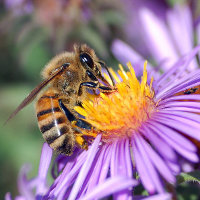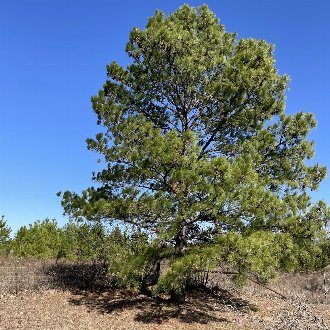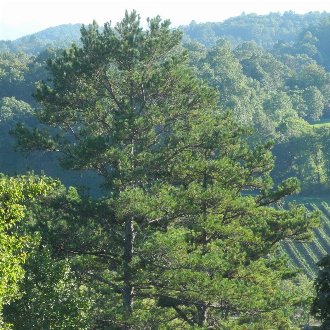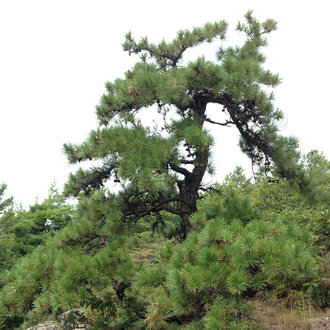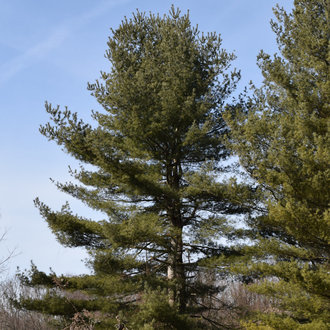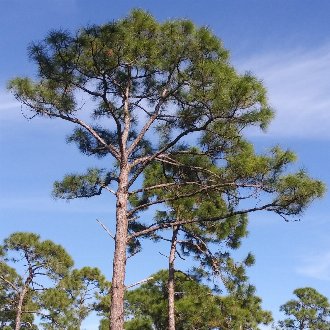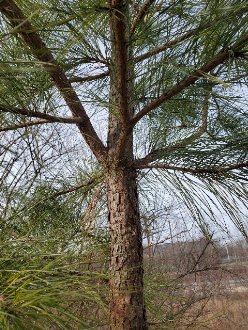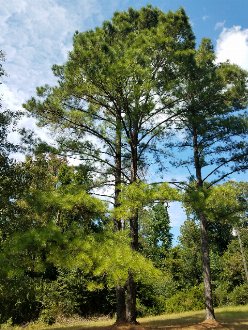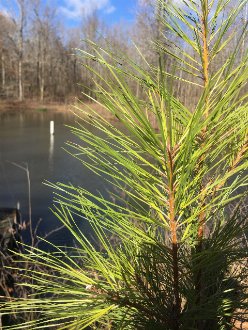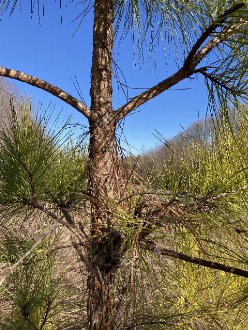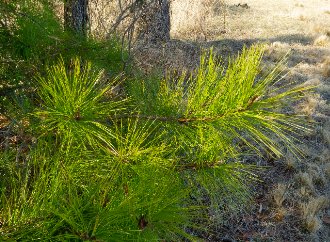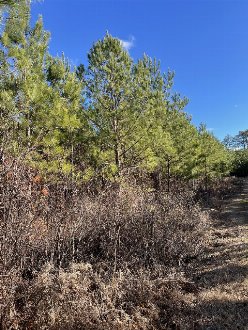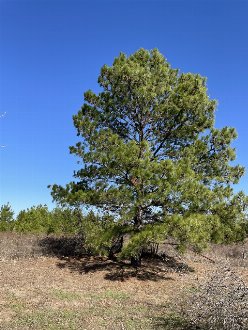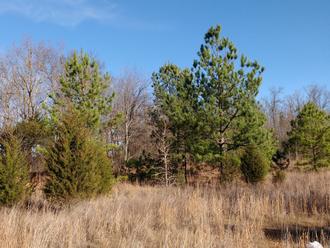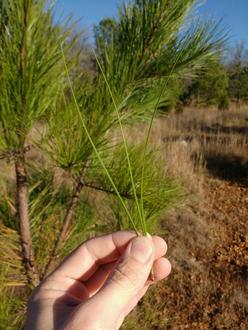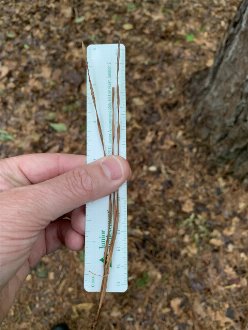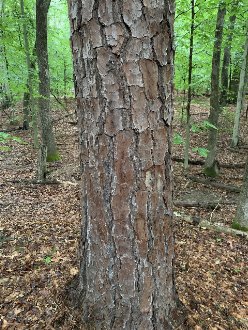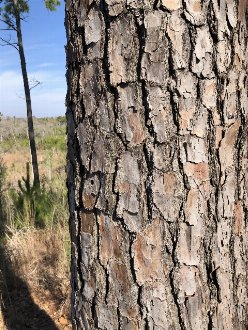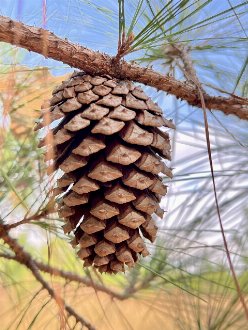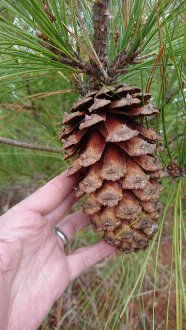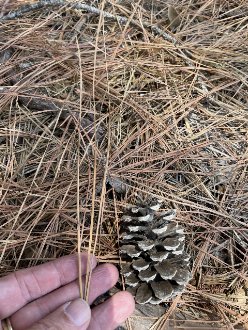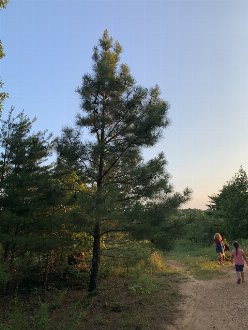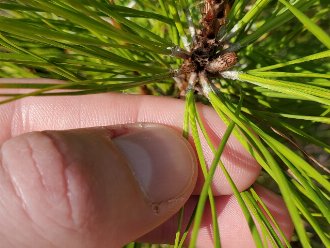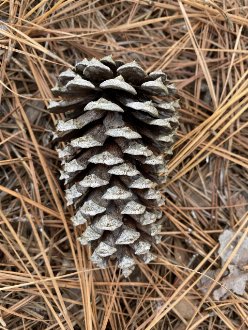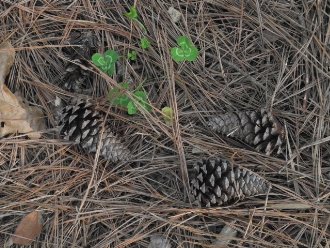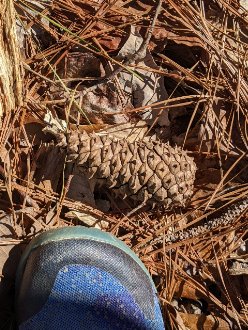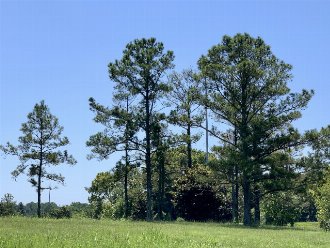Loblolly Pine (Pinus taeda L.)
↑Summary
A pine native to the southeastern US, favoring moist bottomlands, also widely planted in forestry.
↑Range - Expand
| Legend | Color |
| Native or Expanded | |
| Expanded | |
| Native | |
| Native or Not Present | |
| Expanded or Not Present |
This map is based on our research. We have checked its accuracy to Level 3 ecoregions. Although this plant occurs somewhere in each of these regions, it may only occur in a small part of some or all of them.
This species has been widely planted for timber plantations, resulting in new populations slightly north of its native range, mostly near the confluence of the Ohio and Mississippi Rivers. We mark these populations as expanded rather than introduced because they are directly adjacent to its native range.
↑Similar Plants
↑Habitat
Loblolly pine is found throughout the southeast in a wide range of mesic-to-wet, early-successional habitats, including abandoned fields, clearcuts, and other disturbed sites. It prefers poorly-drained sites, except in the south of its range, and found on both flat and sloped terrain. It occurs both in pure stands and mixed with hardwoods and other pines, and it ranges from scattered or isolated individuals in some habitats to dominant in others.
It is adaptable to a wide range of soil types, but prefers moderately acidic soils, tolerating a pH as low as 4, and usually restricted to sites with pH below 6, being more common on sites towards the lower end of this range. In most of its range, it prefers soil with poor surface drainage, a thick, medium-textured surface layer, and fine-textured subsoils. Primarily found on utilsols, highly weathered acidic soils common in the southeastern U.S. Throughout most of its range it is most common on moist sites, also found on mesic sites and occasionally on dry sites. In the south of its range, where fire risk is higher, it becomes absent from wet or poorly-drained sites, and mostly restricted mesic sites with to loamy soils, or occasionally on sites where sandy surface soils is underlain by a layer of clay, creating similarly mesic conditions.
Loblolly pine inhabits a climate zone with 40-50 inches of rain annually and 6-10 frost-free months. It is generally found up to elevations of 1,200 ft (365m) and restricted to lower elevations in the north of its range. Multiple USDA documents say that Loblolly pine is limited to elevations above 500 feet, but this is clearly erroneous as it is common in the coastal plain where elevations are consistently below this level, even near the southern limits of its range. It is limited by low temperatures in the north and at high elevations, and by low rainfall in the west.
It can persist indefinitely on sites that burn on average once every 10 years, but is generally absent from sites that burn much more frequently, where it is replaced by longleaf pine (Pinus palustris); on sites that burn less frequently it is usually replaced by hardwoods, but it can be found temporarily in early successional stages. Fire suppression can cause this species to move into areas that would naturally be dominated by more fire-adapted species such as longleaf pine, but it can also cause it to be replaced by hardwoods on moister, richer sites.
Humans have hugely increased the habitat for this species through a combination of fire suppression and clearing of forests, leading to more early-successional habitats. Climate change is also allowing it to survive slightly farther north than its natural range, especially in the interior part of its range. Its numbers have also been increased by widely planting it in forest plantations. Previously, loblolly pine was more restricted to moist bottomlands, but it is now more common on drier uplands as well. However, these upland sites are not ideal habitat for this pine and its abundance on them may be more a function of widespread planting and forestry practices to intentionally favor this species than suitability.
↑Life Cycle
Lobolly pine is a fast-growing, large evergreen tree with a medium-length lifespan.
Seeds germinate mostly on exposed mineral soils, such as following fire. Seeds require dormancy and germinate in March or April. Ungerminated seeds do not usually survive and there is no seed bank.
Seedlings require adequate moisture, and have some shade tolerance, and their rapid growth (2-3 feet per year) can also allow them to overtop competing vegetation. Although young plants have moderate shade tolerance, established plants are more intolerant.
Trees begin producing cones at 12-18 years of age, but seed viability is not high until age 25.
Flowering and seed production is a multi-year process, initiated in summer, followed by bud production in fall. Pollen release then occurs in spring, but timing is irregular, triggered by temperature. Cones mature September-October, with seeds released primarily in November, most falling by mid-December. Seed production is irregularly cyclical, dependent on weather conditions. High production occurs every 3-6 years, and is hindered by dry conditions in early summer or frosts at the time of flowering.
Trees over 75 years in age often develop heart rot, and are eventually killed by insects, especially the southern pine beetle. However, under good conditions trees can live up to 275 years. In part because this species is so important in forestry, factors causing mortality have been extensively studied and documented. This tree's lifespan tends to be much higher when it is growing naturally in wild ecosystems, and it is often shorter-lived and less healthy when planted in plantations or landscaping, in part due to being grown on sites it is not ideally suited to.
Mortality is usually caused by multiple interacting factors, with gradual decline often happening over a period of a few years, but sometimes progressing rapidly. Healthy trees on suitable sites are windfirm and not usually damaged by wind. However, trees with cankers caused by fusiform rust become more vulnerable to wind damage. Trees growing on shallow or thin soil, on coarse-textured soils (coarser than its natural habitat) or on sites recently artificially thinned by selective logging, are also more prone to windthrow.
Isolated trees especially on upland sites are more likely to be struck by lightning; although lightning usually does not kill the tree, insect infestations often kill trees following lightning strikes.
In the north of its range, especially on trees planted outside its native range, winter cold or weather can cause mortality. Ice storms are the most damaging, which leads to branch and stem breakage, and in extreme cases can cause uprooting if the ice storm is followed by wind. Ice damage is also more common in recently-thinned stands and in monoculture plantations where trees are planted closer together than they would occur in the wild.
Heat and drought can stress mature trees especially when planted on drier uplands; although trees rarely die immediately in response to heat or drought, the resulting stress often leaves the trees susceptible to insect infestation.
Trees in bottomlands are more likely to die from flooding; deep flooding for more than 2 weeks during the growing season can kill mature trees. Often, trees do not die immediately but instead die in the second growing season after flooding.
Trees grown in high pH soils are more prone to root rot, especially on sites with warm soil temperatures.
↑Faunal Associations
Loblolly pine has key importance as cover and a structural component of ecosystems in which it occurs. It is especially important as habitat for white-tailed deer, northern bobwhite, wild turkey, and grey fox squirrels. The endangered red-cockaded woodpecker utilizes older loblolly pine trees with heart rot for its nesting. The tendency to harvest loblolly pine before 50 years of age has played a role in the decline of this woodpecker.
The seeds are eaten by numerous songbirds. Two warbler species favor loblolly stands for nesting: pine warblers, which prefer pines in general, and yellow-throated warblers, which are found in a range of bottomland forests. Pine warblers utilize these trees year-round, including in wintering and migration.
Numerous insects eat the trees, but most of them rarely cause any damage. The insect most likely to cause severe damage is the southern pine beetle (Dendroctonus frontalis), a native insect which also eats numerous other pine species. Other insects sometimes causing damage include pine engraver beetles (Ips sp.), and weevils of the Hylobius and Pachylobius genera, which feed on the bark of seedlings. Leaf-footed bugs of the Leptoglossus genus and Neodiprion sawflies feed on the seeds and sometimes damage seed crops.
Numerous lepidoptera have been recorded eating this species. The snout moth Dioryctria taedae and lesser loblolly pineconeworm moth (Dioryctria taedivorella) may be specialists on it. Some species feed on this and other pines, including the eastern pine elfin (Callophrys niphon), Melanocinclis lineigera, southern variable dart moth (Xestia elimata), southern pineconeworm moth (Dioryctria amatella), rusty pine cone moth (Dioryctria disclusa), southern pine sphinx (Lapara coniferarum), longleaf pine seedworm moth (Cydia ingens), shortleaf pinecone borer moth (Eucosma cocana), pitch twig moth (Retinia comstockiana), Nantucket pine tip moth (Rhyacionia frustrana), pitch pine tip moth (Rhyacionia rigidana), and the subtropical pine tip moth (Rhyacionia subtropica).
Some lepidoptera that prefer other species also eat this one, including the baldcypress coneworm (Dioryctria pygmaeella) which prefers Taxodium sp.. A number of generalists also eat it, including the imperial moth (Eacles imperialis. Other species for which less is known, which have been recorded eating this species, include the stripe-backed moth (Battaristis vittella), southern nepytia (Nepytia semiclusaria), black-letter pococera moth (Pococera melanogrammos), northern pitch twig moth (Petrova albicapitana), and the moths Cydia erotella and Rhyacionia aktita. The invasive pine shoot moth (Rhyacionia buoliana) also eats this species.
↑Control
Loblolly pine has established in the wild in several places, including Korea, Eastern Australia, Hawaii, and Réunion (an island in the Indian Ocean); it likely has invasive potential. It is best to avoid planting it in areas not in or adjacent to its native range.
↑Uses
Loblolly pine is the most important timber species in the southeastern U.S. Its wood is valued as being hard and dense relative to other pines, and it is widely used in construction. It is widely planted in plantations, including on upland sites where it would either not occur naturally, or would be scattered and uncommon. Although these plantations are economically productive, trees in them are often less healthy than wild trees, and monoculture plantations are much lower in biodiversity than wild forests.
This species is sometimes also planted to stabilize soil, reclaim land damaged by mine spoils, or as a windbreak or noise barrier. When used as a windbreak or noise barrier, it is best planted together with other, more shade-tolerant evergreen vegetation such as American holly (Ilex opaca), as mature stands of loblolly pine tend to self-prune and become open lower down, undermining its use for these purposes.
In its native range and slightly north of it, it is planted as a landscaping plant and shade tree, where it is valued for its fast growth and its tolerance of poorly-drained sites. Its survival is limited by winter cold and/or moisture and it does not do well much farther north or west than its native range, except in a small region of the central US near and somewhat upstream from the confluence of the Mississippi and Ohio rivers.
When planting this species it is important to use as local stock as possible. This species' survival is limited by tolerance of cold and winter weather in the north of its range, and trees derived from southern populations fare poorly in cold climates. Southernmost populations grow shorter and less straight, reflecting exposure to more hurricanes, and taller trees may be more prone to wind damage in these areas. Westernmost populations are most drought-tolerant and resistant to fusiform rust, two pressures greatest in that area. There are also important soil type differences throughout its range and these may also result in unhealthy trees if trees are planted in a different soil type from the population they are sourced from. Most forestry cultivars have been selected from more northerly Atlantic coastal populations as they combine height and straight form with rapid growth, but these populations can have greater susceptibility to wind, fusiform rust, and drought when planted in other regions.
↑Related Plants
Loblolly pine is closely related to, and can hybridize with shortleaf pine (P. echinata), longleaf pine (P. palustris) to form Sonderegger pine (Pinus ×sondereggeri), pitch pine (P. rigida), slash pine (P. elliottii), and pond pine (P. serotina). With the exception of ×sondereggeri, these other hybrids are not named.
↑Links & External Resources
• Loblolly Pine | The Wood Database (About This Site)
• Loblolly Pine | Fire Effects Information System (FEIS) (About This Site)
• Pinus taeda (Loblolly Pine) | USDA PLANTS Database (About This Site)
• Loblolly Pine | iNaturalist (About This Site)
• Pinus taeda (Loblolly Pine) | Missouri Botanical Garden Plant Finder (About This Site)
• Loblolly Pine | Virginia Tech Dendrology Factsheets (About This Site)
• Loblolly Pine | Silvics of North America (About This Site)
• Pinus taeda | Biota of North America Project (BONAP) (About This Site)
• Pinus taeda | NatureServe Explorer (About This Site)
• Pinus taeda | Flora of North America (About This Site)
• Loblolly Pine | Maryland Biodiversity Project (About This Site)
• Pinus taeda L. | Plants of the World Online (POWO) (About This Site)
• Pinus taeda L. (Loblolly Pine) | Digital Atlas of the Virginia Flora (About This Site)

